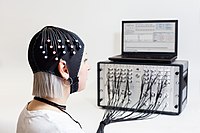Functional near-infrared spectroscopy

Functional near-infrared spectroscopy (fNIRS) is a fancy way of looking inside our brains to see what happens when we do different things, like see something or talk to someone.
Imagine your brain as a huge playground with lots of different toys. When we use a toy (or a part of our brain) it needs more energy to function, a bit like when you run around and feel out of breath. This extra energy creates tiny changes in the amount of oxygen in the blood that flows through that part of the brain.
That's where fNIRS comes in. A little hat-like device with tiny lights is placed on your head. These lights shine through your skull into your brain and measure the amount of oxygen in your blood. This tells us which parts of your brain are working harder when you play with different toys.
Scientists use fNIRS to study all sorts of things, from how babies learn to recognize faces to how athletes make decisions in the heat of the moment. It’s kind of like a spy camera for your brain!
Imagine your brain as a huge playground with lots of different toys. When we use a toy (or a part of our brain) it needs more energy to function, a bit like when you run around and feel out of breath. This extra energy creates tiny changes in the amount of oxygen in the blood that flows through that part of the brain.
That's where fNIRS comes in. A little hat-like device with tiny lights is placed on your head. These lights shine through your skull into your brain and measure the amount of oxygen in your blood. This tells us which parts of your brain are working harder when you play with different toys.
Scientists use fNIRS to study all sorts of things, from how babies learn to recognize faces to how athletes make decisions in the heat of the moment. It’s kind of like a spy camera for your brain!
Related topics others have asked about:
